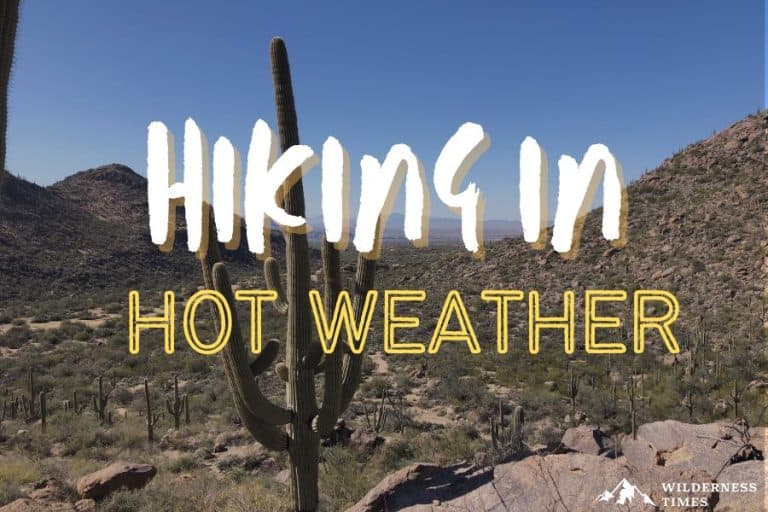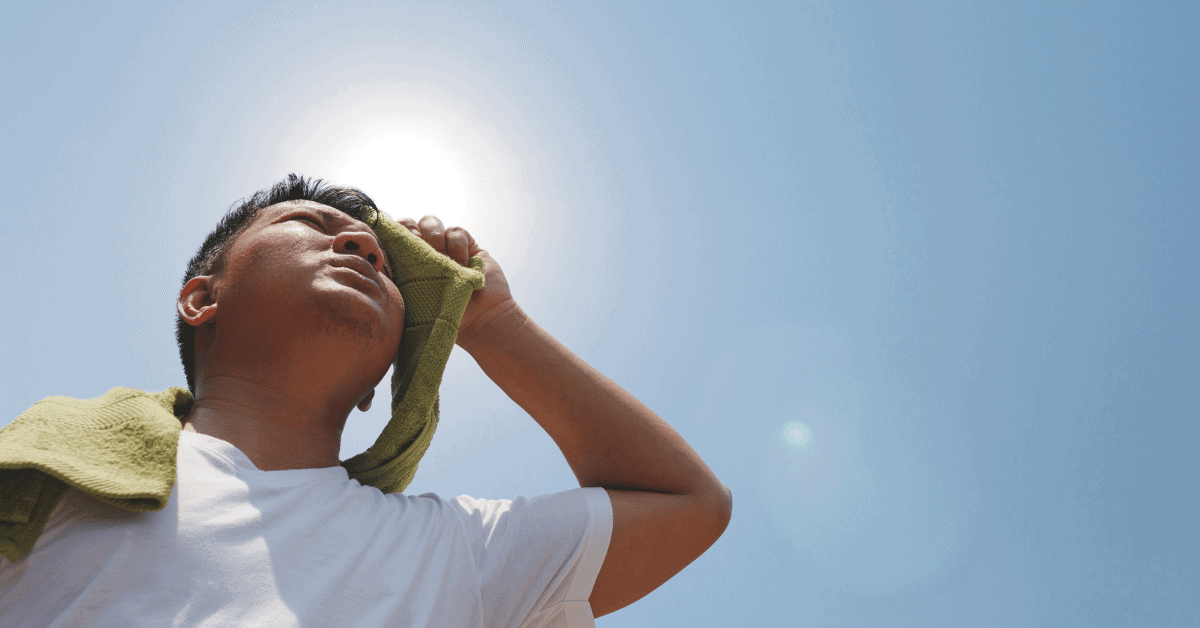Hiking in hot weather can be a lot of fun… if you’re properly prepared.
If you’re not, you can end up dehydrated, sunburned, and exhausted.
In this article, we’ll tell you how to prepare for a hot weather hike so you can avoid all of that and have the time of your life.
Ready to get started?
Let’s dive in!
Table of Contents
Toggle12 Tips & Tricks For Hiking In Hot Weather Safely
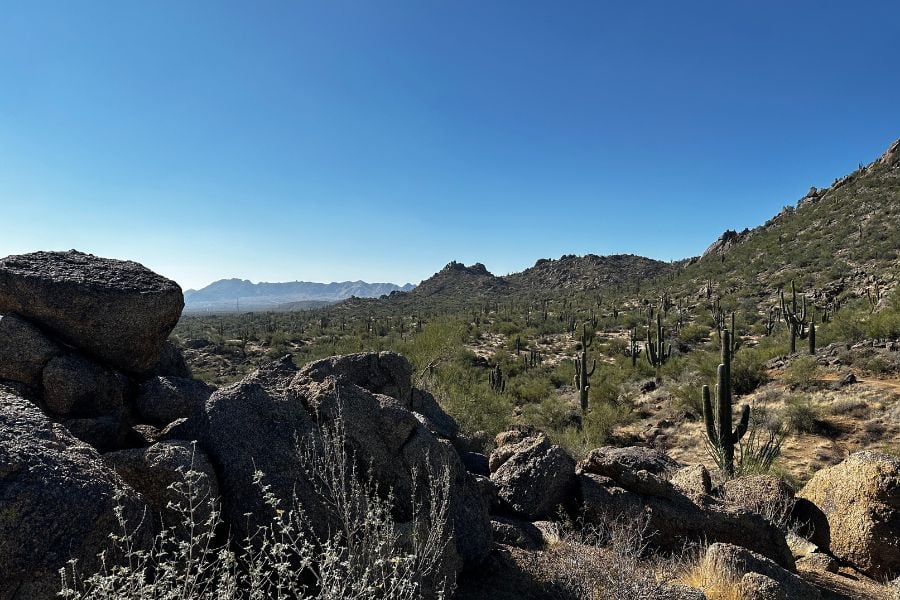
Now, being aware of the dangers of hiking in hot weather is not to say hiking in hot weather should be avoided altogether.
In fact, in some areas, the weather is either hot or cold and nothing in between – so there’s no such thing as perfect conditions.
In reality, you can enjoy hiking in hot weather, as long as you take a few precautions.
Here are a few of our favorite hot weather hiking tips and tricks to keep in mind next time you’re heading out on a blazing hot trail.
Start Early
If you’re a morning person, this part will be a piece of cake. If you’re anything like me, getting out of bed at the crack of dawn is going to be a struggle.
Trust me though, when it comes to hot weather hiking, it’s definitely worth making the effort.
On a hot day, high temperatures will have often already peaked by 11 AM.
Considering most of the steep climbing you’ll be doing is likely to be towards the beginning of your trail, it’s best to try and get that part done while it’s still slightly cooler.
Inform Others Of Your Plans
When I first started hiking, I thought I was too independent to tell others about my plan. I’m not a kid, right?
Well, that’s a pretty dumb perception, and I’m definitely glad I didn’t learn that the harder way. Because if something had happened to me during those hikes, no one would have known where to look for me.
The moral of the story: always tell someone where you’re heading. And I don’t mean just saying “a portion of the Pacific Crest Trail” –because that thing is 2,650 miles long and goes through three states.
Instead, be precise about the section you plan on covering, as well as the time you plan on getting back.
This way, if you do end up getting ill on the trail, then someone will know where to find you and when to go looking.
It’s better to be safe than sorry.
Wear The Right Kind Of Clothing
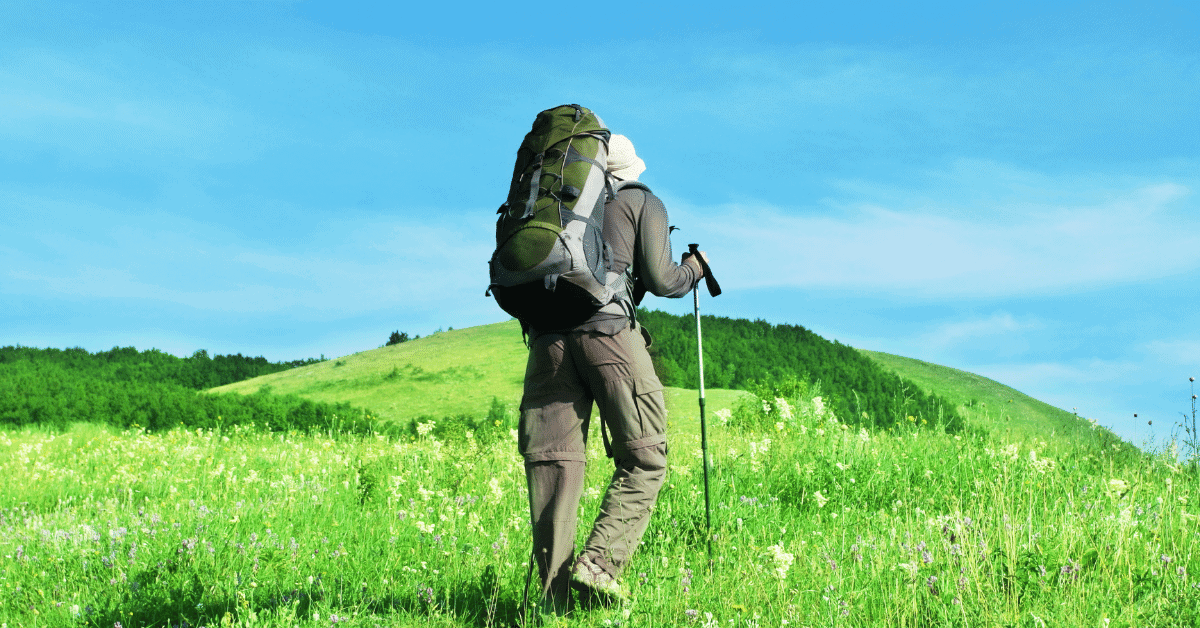
When it’s hot out, your instincts would probably lead you to wear as little clothing as possible. However, the truth of the matter is that you’re much better off covering up than stripping down. Keeping as much of your skin covered as possible, will protect you from getting burnt. It’s especially important to cover areas like your shoulders, as the sun beats down on them directly.
Make sure to wear a hat. A wide-brim hat or a cap with a neck flap is best. If your hat doesn’t have a neck flap, a neck gaiter is another great way to protect your neck.
Wear loose-fitting clothing that’s made of cotton.
Yes, you read that right. Cotton.
Many people advise against wearing cotton when you’re hiking. For the most part, I agree with them wholeheartedly. Cotton retains water and it’s slow to dry. In hot weather though, this is actually a plus.
Avoid cotton hiking socks, though. Wool is a much better option. Also, make sure your socks fit properly.
Wet your clothes (including your hat and neck gaiter) as often as possible. This will do wonders for keeping you cool.
Wear Plenty Of Sunscreen
When it comes to summer hiking, it’s important to wear sunscreen with an SPF factor of at least 30 for adequate sun protection. In extreme conditions, it’s a good idea to go for an even higher factor, such as 50.
Of course, the more sensitive your skin is the more UV protection you’re going to need.
Slather it on generously, and reapply as often as needed.
If you’re sweating a lot, you’ll need to be reapplying your sunscreen more often than you usually would.
Make Sure You’ve Got Enough Water, But Don’t Overdo It
Have a solid plan in place to make sure you have enough water. When there’s a natural drinking water source along the way, take full advantage.
If there aren’t any, get a water purification system to filter water you come across along the way. If you’re hiking in an area where there isn’t any water, make sure you take enough with you to keep you hydrated for the duration of your hike.
Drinking enough water will protect you from dehydration, but make sure you don’t drink too much, or you put yourself at risk of becoming overhydrated.
A good way to regulate your H2O intake is by using a hydration pack. If you’ve got one of these, you can take a few sips every now and then without having to stop and take your water bottle out.
Monitor Your Heart Rate
Remember what we said about heat exhaustion and your body not being able to keep up with the heat?
Well, one thing our bodies do when it gets too hot outside is speed up blood circulation in order to cool the body down.
And to do that, our hearts need to beat faster and pump harder.
Like, really hard.
According to studies, a temperature increase of 20° F can cause your heartbeat to increase by 10 beats-per-minute compared to the workout you do on a cooler day.
When you’re hiking in hot weather, your heart rate will inevitably go up after a certain time. But, you can prevent it from climbing rapidly by keeping it in check.
To do that, you can simply wear a heart rate monitor.
That way, when you see your heart rate going up, you can slow down and prevent overstressing your body and getting dehydrated as a result.
Keep Your Salt Levels Balanced
It’s important to drink enough water to replace the water you lose through sweat.
But, drinking water while you hike is not enough. You also sweat out important minerals, such as sodium and potassium. These will also need to be replenished, in order to keep your energy levels in check and avoid succumbing to heat exhaustion.
The best way to do this is with sports drinks that contain electrolytes, and salty snacks containing complex carbs, such as trail mix.
Combining complex carbs with a starchy fruit, such as a banana or apple, provides a particularly effective slow-burning energy boost out on the trail.
Get Wet Whenever You Can
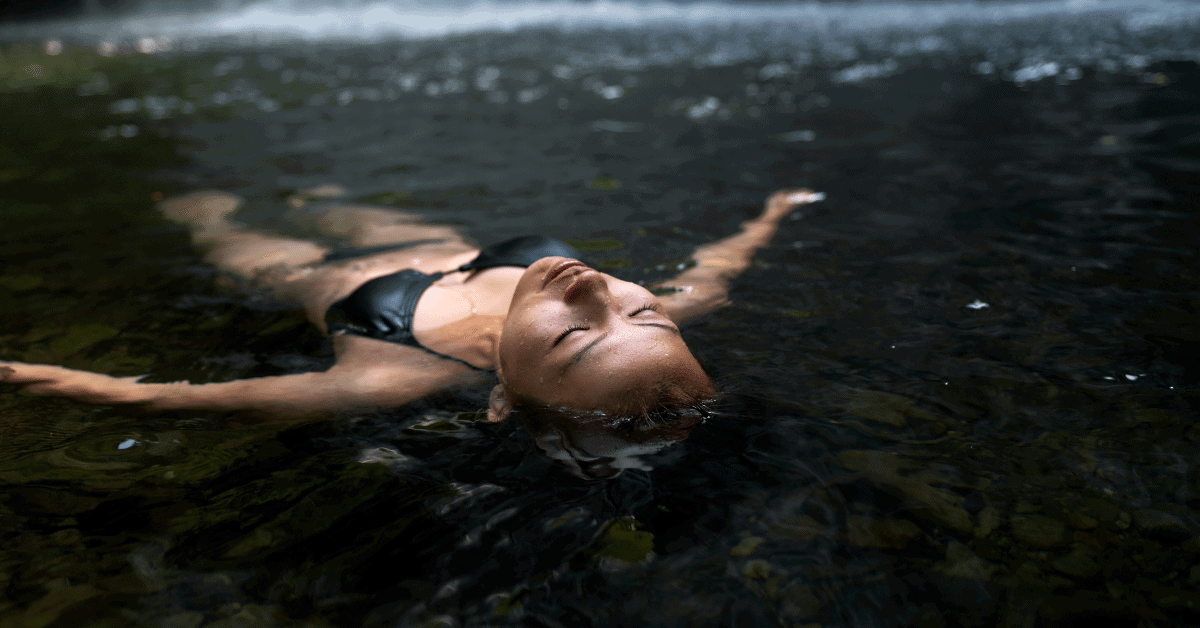
Anytime you come across a river or lake on your hike, jump in to cool your body down. Even if it’s just a trickling stream, take your shoes off and soak your feet in the cool water. This will greatly assist your body in regulating its internal temperature, protecting you from the onset of various heat-related illnesses.
As I already mentioned, it’s a good idea to wet your clothes and hat, too. Just not your shoes, of course.
Don’t Ignore A Headache
One symptom that almost every heat-related illness has in common is a headache. If you experience a headache while hiking in hot conditions, don’t keep pushing yourself. Take a break, find a nice shady spot to sit or lie down, drink some water, and rest until the headache passes.
If it hasn’t subsided within 20 minutes, you should probably think about calling it quits and heading back, to be safe.
Take Regular Breaks In Shaded Areas
In summer, hiking along the coast may seem like an ideal option. After all, the seasides are almost always breezy, so you won’t feel the heat, right?
Well, that’s not quite true. Just because you might not feel the sun, doesn’t mean it doesn’t affect your body.
However, I’m not saying hiking along the coast is bad. In fact, the breeze does make it much easier.
Still, you should make sure to take regular breaks away from the sun. This is especially important during the hottest parts of the day, like when the sun is highest in the sky.
So, once you find a suitable shaded place, take a rest and let your body cool down. In the meantime, don’t forget to drink fluids and grab a snack to refill your energy levels for the upcoming parts of the trail.
Remember not to push yourself too hard, too. It’s perfectly okay – even desirable – to take a longer break during the time of the day when the heat is at its peak.
Once the sun starts coming down, hiking will be much more comfortable.
Choose Your Trail Wisely
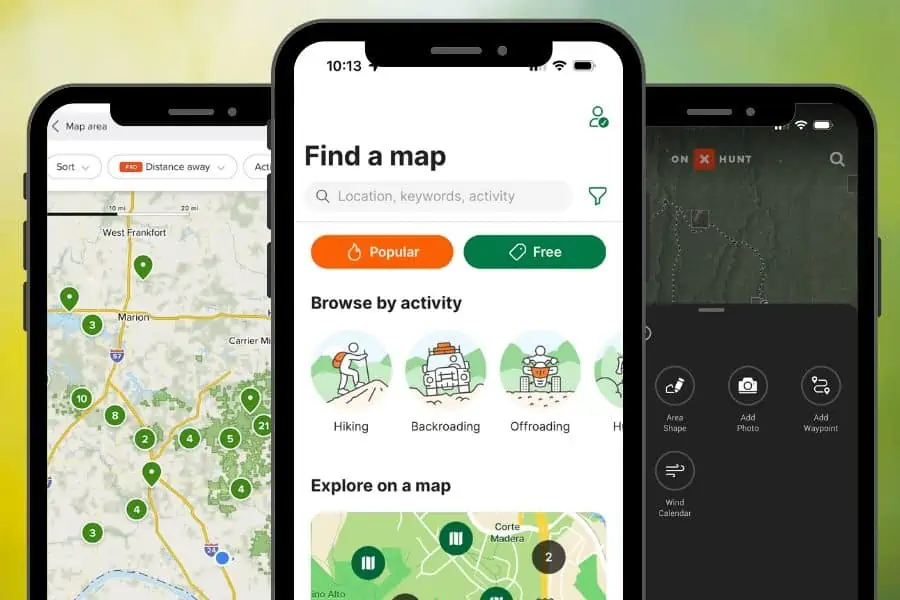
If you want to stay as cool and comfortable as possible while you’re out hiking in the sun, it’s important to choose an appropriate trail.
We recommended downloading a free hiking app and reading through the reviews as well as looking at any pictures that are available.
For starters, you’ll want to make sure there’s enough water along the way. It’s also a good idea to have a good amount of shade on your trail. It doesn’t have to be along the entire trail, but at least from time to time, so you have a shady place to take a break and cool off.
Also, keep in mind that the weather is cooler at higher altitudes. For a more pleasant hike, choose a trail that’s higher up in the mountains.
Remember to check the weather before you set out, though. Weather can be unpredictable, especially up in the mountains. I can’t tell you how many times I’ve set off for a hike on a sunny day with clear blue skies, only to be caught in a sudden storm that comes out of nowhere. It’s not much fun, believe me.
Acclimatize To The Heat
Natives are pretty used to the heat, and they don’t find it as drastic as those living in colder states.
But even natives can get into trouble if they don’t properly prepare and make sure they are in tune with their bodies – especially if you haven’t hiked in the heat lately.
If you are traveling to a hotter location or more humid location, you are going to want to give yourself even more time to acclimate to the change.
That doesn’t mean hiking in hot weather is practically unbearable for people coming from cooler areas. Instead, you just need a bit of acclimatization.
How do you do that, you might ask? It’s actually pretty simple. You simply need to spend more time in the heat prior to your trip.
By more time, I mean at least a week or two of regular exercise in hot weather.
Of course, that doesn’t mean spending the whole day in the sun trying to get used to it. Instead, go with hour-long training sessions over the course of two weeks to get the best head start when it comes to heat tolerance.
The Dangers & Risks Of Hiking In Hot Weather
Heat Stroke
When you’re out on the trail in hot weather conditions, your internal body temperature can get quite high. If your body is unable to regulate this sufficiently through sweating, you could become susceptible to heat stroke.
Symptoms of heat stroke range from a headache, nausea, and confusion to seizures and even coma.
Heat stroke can be quite serious, so you definitely want to avoid it by helping your body stay cool in every way you can. This includes keeping your clothes wet and jumping into any water you come across along the way.
Heat Cramps
Overexerting yourself while hiking in hot weather can lead to painful muscle contractions. These are known as heat cramps. If you experience a heat cramp, it’s a clear sign you need to slow down and cool off before heat stroke begins to set in.
Heat Exhaustion
Another issue that can occur when your body is unable to cope with the stress of excessive heat is heat exhaustion. Signs that you may be experiencing heat exhaustion include heavy sweating, a rapid pulse, dizziness, nausea and a headache.
Dehydration
Not getting enough water can cause you to become dehydrated, which can contribute to other heat related illnesses, such as heat stroke and heat cramps.
In itself, dehydration can give you a headache and cause you to become dizzy and nauseous. So, make sure you’ve got plenty of water available when you’re hiking in hot weather.
Overhydration
On the other hand, overhydration, otherwise known as hyponatremia, is just as real of a threat. Other than not drinking too much water, this can be avoided by keeping your salt levels stable with a salty snack or sports drink.
The symptoms of overhydration are similar to those of dehydration, except that it’s far more dangerous. In fact, it can even result in coma or death. (To be fair, this isn’t very likely – but it still pays to be cautious!)
Sunburn

We’ve all been burnt by the sun at some point or another. It’s never much fun, but if you’re out hiking in extreme heat without enough sun screen and the right kind of clothing, you’ll be looking at a far more serious sunburn than you may have thought possible.
You might not realize it, but the sun can burn you so bad that you end up with 2nd degree, and in some cases even 3rd degree burns. Yikes!
In the long term, repeated exposure to the sun can lead to melanoma. This is why it’s important to protect your skin and avoid getting burnt.
Recognizing Signs Of Heat-Related Illnesses
While it might not sound that way, heat-related illnesses are very serious. They occur when your body temperature gets too hot, and they can be life-threatening if not treated in a timely manner.
The first step is recognizing the beginnings of these illnesses.
Symptoms Of Heat Exhaustion
Heat exhaustion happens when your body tries to deal with overheating through excessive sweating.
Elderly people and those with chronic diseases (like diabetes or health problems) are more likely to experience heat exhaustion. However, it can happen to anyone who is spending too much time in a hot environment.
Symptoms of heat exhaustion can appear abruptly or get worse over time, and they include:
- Nausea
- Dizziness
- Headache
- Fatigue
- Thirst
- Sweating
- Above-normal body temperature
- Muscle cramps
Warning Signs Of Heat Stroke
Among heat-related illnesses, heat stroke is by far the most serious one. It’s extremely important to pay attention to the symptoms, as heat stroke can damage the organs and even result in death if not treated right away.
Symptoms of this dangerous condition are:
- High body temperature (104°F and above)
- Confusion
- Slurred speech
- Nausea and vomiting
- Rapid breathing and racing heart rate
- Seizures
- Coma
If a person is experiencing the symptoms of heat stroke, they need immediate medical treatment.
In the meantime, do everything you can to cool down their body, whether it’s with a shower, a misting fan, an ice pack, or whatever cooling tools are at-hand.
Identifying Heat Cramps
How are muscles and heat connected, you might ask?
Among other things, our body cells use sodium to send electrical impulses to our muscles to contract and relax.
But when you sweat, all that salt comes out on the surface and not into your muscles.
And without it, the ability to send those signals is interrupted, and the brain tries to make up for that by sending way too many impulses.
As a result, muscles become overwhelmed and start cramping.
Some symptoms of heat cramps are:
- Cramps and spasms (mainly in the legs)
- Flushed skin
- Slightly elevated body temperature (typically less than 102.5°F)
Obviously, these symptoms are nowhere near as dangerous as the ones of heat exhaustion and stroke.
But, they’re a clear sign that you should slow down, or else these cramps could turn into a more severe heat-related illness.
Hot Weather Hiking Gear Recommendations
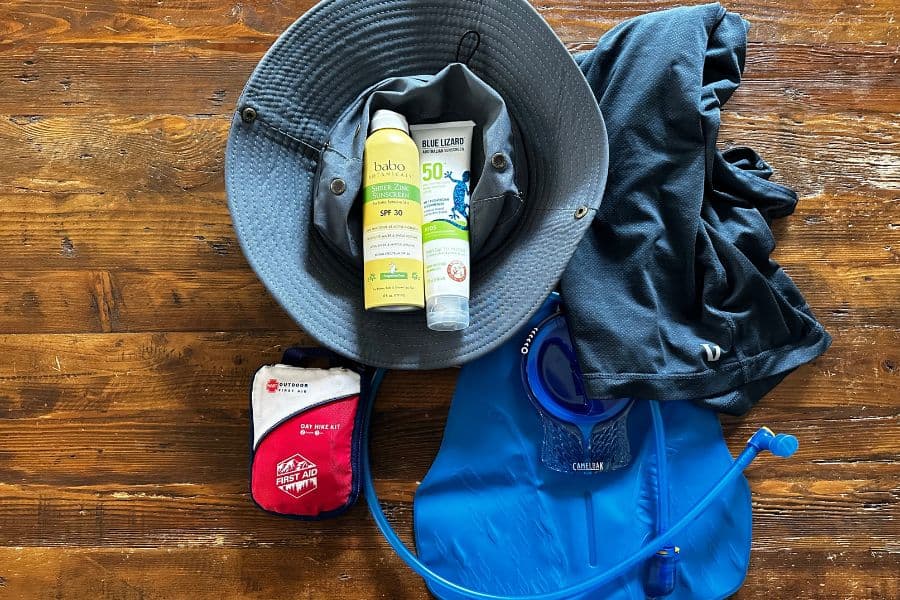
Gear is definitely something that can make or break your trip, especially when it comes to staying cool and safe.
You want to stay as cool and as dry as possible and to do that, you need to bring specific hiking gear.
Clothing
Not dressing according to the weather can be really frustrating, even when you’re just running errands.
So naturally, wearing the wrong things when you’re hiking in hot weather can be disastrous.
That’s why you should pay special attention to the type of clothing you choose to wear.
One thing that’s true for every piece of clothing is color: go with light colors like white or tan. Light colors reflect light, while dark colors attract it.
This means that the darker the color, the hotter you’ll be. Therefore, you’ll be much more comfortable in lighter shades.
Moisture-wicking Shirts
When it comes to shirts, it’s crucial that they’re moisture-wicking. Not only do we sweat the most under our arms, but you’ll probably be carrying a backpack, so your back will sweat, as well.
Avoiding sweating in heat is pretty much impossible – but the choice of garments can make it more comfortable.
Materials like Merino wool or synthetics (polyester or nylon) are ideal options for a shirt. Not only do they wick away sweat, allowing you to cool down, but they also dry rather quickly.
When it comes to Merino wool, it’s also odor resistant, so you can rest assured you won’t be smelled from miles away.
Now, while wearing short sleeves sounds intuitive during hot weather, I’d recommend going with long sleeves instead.
That way, your arms are also protected from sun exposure, which is part of what causes overheating and heat illnesses.
Breathable Hiking Pants Or Shorts
Just like the shirt, your bottoms should also be breathable.
So, while hiking leggings might be your first choice during colder days, you should opt for something looser during hot weather.
Again, the pants should also be quick-drying, which is where nylon, polyester, and Merino shine.
While the pants of your choice don’t need to be specifically designed for hiking, you can definitely benefit from having pants specialized for this kind of activity.
At the very least, many hiking pants feature vents that allow you to stay cool while on the trail.
What about shorts, you might ask?
Well, shorts are great when it comes to ventilation. The reason I prefer pants over shorts is that they keep you safe from both the sun and the branches, thorns, and pickles you might encounter on the trail.
Wide-brimmed Hat
Your face and neck need extra protection from the sun, so wearing a hat is a must when hiking in hot weather.
Now, keep in mind that your head can sweat just as much as the rest of your body. That’s why it’s important that you choose a hat made of breathable fabric.
While it’s not absolutely necessary for the hat to have a chin strap, it’s definitely a handy feature in case the wind starts blowing.
You don’t want to run in the opposite direction from your trail just to catch your airborne hat , do you?
UV-protective Sunglasses
Not all sunglasses are the same when it comes to UV protection. What’s even worse: a higher price doesn’t always mean more protection.
That’s why it’s important to pay attention to how protective glasses actually are before using them on the trail.
If a pair of glasses don’t have the UV protection stated, it’s very possible they don’t offer any kind of protection against ultraviolet radiation.
Since you’ll be out for a while, you should go with UV-400 sunglasses, which offer between 99% and 100% UV protection.
Buff Or Bandana
While a wide-brimmed hat offers a bit of sun protection for your neck, it’s not ideal. That’s why you should also wear a buff or bandana.
Between the two, there’s very little difference in terms of neck coverage.
However, while a bandana is more versatile, a buff is more convenient to wear. That’s something to keep in mind when choosing between them.
Lightweight, Moisture-wicking Socks
Socks are just as important as your footwear. If they’re not comfortable, your hiking trip will be a disaster.
It’s crucial that your socks are lightweight and moisture-wicking, as you don’t want them drenched in sweat.
Not only is it uncomfortable, but all that trapped moisture is great for growing bacteria. Yuck.
To avoid having sweaty feet, stay away from cotton, as it takes forever to dry. Instead, go with synthetic or Merino wool socks.
You should also make sure the socks fit you perfectly. Socks that are too big for your feet can wrinkle inside the shoes, causing blisters.
Footwear
Be it summer or winter, having proper footwear is essential for hiking. For hot weather, you have two options:
Ventilated Hiking Shoes Or Boots
Hiking shoes or boots are, hands down, the best option for hiking since they’re designed to protect your feet from harsh terrain.
When choosing hiking boots or shoes for hot weather, make sure they’re breathable. If your feet are constantly sweaty, you’ll get blisters.
So, while your waterproof winter boots might be comfy, they’re not suitable for this kind of weather.
Lightweight Trail Runners (For Shorter Hikes)
If you’re going on a shorter hike, you may not need to bring heavy hiking boots. Instead, light train runners should do the trick.
That is, of course, if the trial allows it. While they do provide decent traction and support, trail runners aren’t really great for very rocky terrain.
Hydration
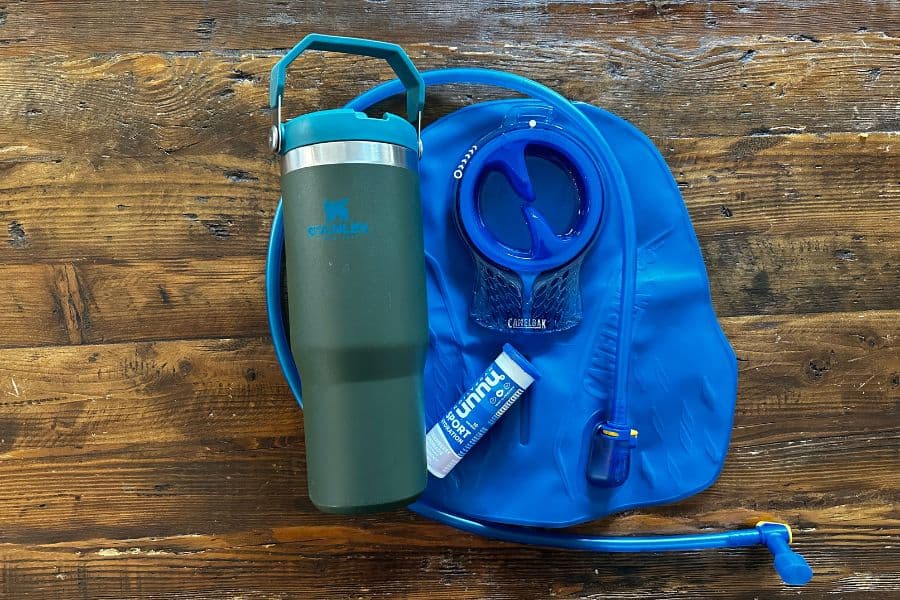
I can’t stress enough how important it is to stay hydrated throughout the entire hike.
Insulated Water Bottles
One option for staying hydrated is to go with an insulated water bottle. You probably already own one, and it will work well at keeping your water cool for a certain amount of time.
What’s also great about bottles is that most backpacks have those side mesh pockets, which are ideal for storing water bottles close at hand.
Hydration Bladder Or Reservoir
A hydration bladder or reservoir has the advantage of not having to take it out of the backpack every time you want a sip of water. Plus, they can hold more water compared to classic water bottles.
And to be frank, you should be sipping water throughout the hike.
You lose a lot of body liquid through sweat, so it is important to steadily replenish that over the course of the trail.
Nowadays, many hiking backpacks have a special compartment just for the hydration bladder, so carrying one around is easy.
Electrolyte Replacement Tablets Or Powders
When you sweat, you don’t just lose water; you also lose electrolytes, which are necessary for proper body functioning. The ones you lose the most through sweat are sodium and chloride.
To make up for those electrolytes, you should carry electrolyte replacement tablets or powders with you.
Aside from that, you should also pack some salty snacks, as they can also help you replace what your body has lost through sweating.
Sun Protection
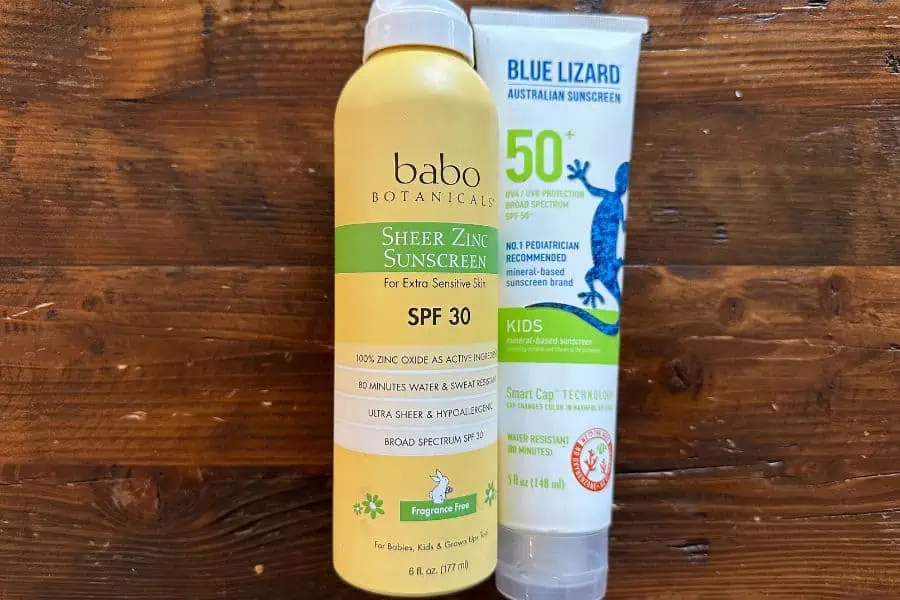
Spending time in the sun is healthy – but only if you’re protected against sun damage.
Here are some sun protection things you should always have:
Sunscreen (SPF 30 Or Higher)
First and foremost, never go hiking without sunscreen. This is something you should be using 24/7, 365 days a year.
But it’s even more important to use during the summer months, when the sun is out the most.
For hiking, aim for an SPF rating of at least 30, which protects you against 97% of UV rays. Of course, the higher the rating, the better it will prevent skin damage.
You should also keep in mind that sunscreen effects last for about two hours. This means you need to reapply it every two hours for it to keep you safe from sun exposure.
Lip Balm With SPF
Don’t forget about your lips, either! In fact, they’re even more sensitive to sun damage than our skin.
Not every lip balm has SPF, so pay attention to the label when buying one for your hiking trip.
UPF-rated Clothing
Did you know your clothing garments can also have sun protection?
UPF is the rating used for clothing, and it’s pretty similar to SPF. The only difference is that SPF protects against UVB rays, while UPF protects against both UVA and UVB rays.
As you can see, clothing can be a better skin protector than sunscreen. This is why you’ll see many hikers wearing long sleeves and pants: the clothes they’re wearing have a UPF rating and are protecting them from the sun.
How much do you need? Well, a UPF rating of 30 lets 1/30th of UV radiation through, which is roughly 3%.
That’s pretty great and should be a minimum when choosing clothing for hiking.
Accessories
There are a few other accessories that could make your trip better for keeping you cool and safe.
Cooling Towel
If you are worried about heat illness, you can always wet a bandana and place it around your neck to cool down.
But cooling towels are specifically designed for that purpose and work much better.
Made of synthetic materials, the cooling towel stays wet (but not dripping) for a long time. This will give you a consistent cooling effect, unlike a random piece of wet cloth.
What’s also great is that most cooling towels have a UPF rating, so they also keep you safe from the sun.
Portable, Lightweight Umbrella
They’re not just for rain: umbrellas can also serve as protection against the sun.
Of course, I don’t mean just any umbrella. Nowadays, you can find backpacking umbrellas which are extremely light, can be attached to the backpack for hands-free use, and have high UPF ratings.
Collapsible Trekking Poles
Trekking poles are generally great for any type of hike. They protect your knees, make you more stable, and allow you to keep a steady rhythm.
This is especially useful in hot weather, as the heat can make you feel weaker. Having these for added strength is a definite plus.
Insect Repellent
Bugs are everywhere during hot weather.
And without a bug spray at your disposal, your trip can quickly turn into a disaster.
Plus, there are plenty of options available: from classic DEET sprays to alternatives like picaridin or permethrin.
Alternatively, you can go with natural repellents made of essential oils, although they might not be as strong as chemical ones.
Navigation & Safety
Getting lost is never fun, especially when you’re out in the sun without a shelter in sight.
But that can easily be avoided with a few navigational tools. There are a number of options available to help you find your way around and keep your time in the sun to a minimum.
Map & Compass
Having a map and a compass is always a great idea. They have been used to navigate for centuries, so why question Ol’ Reliable, huh?
A map can be folded down and a compass is usually small, so they can both fit in your pack or on your person very easily.
Plus, electronics can fail. So, having something that is foolproof like a map and a compass will definitely ensure you have a way out if things go south.
GPS Device Or Smartphone With GPS App
Modern phones all have GPS apps, so finding your way around shouldn’t be hard. You can download different maps, create your route, and track your current location with them.
Still, you’re dependent on the phone battery, and if it goes dead – your phone is useless.
If you’re hiking short distances, battery life shouldn’t be a problem. But for longer trips, it’s better to go with a GPS device.
With GPS devices, battery life is not something you need to worry about quite as much, as many models like the Garmin inReach Mini 2 have up to 14 days of battery life in full-sky view.
Furthermore, they can provide information like topo maps, altitude readings, recorded mileage, etc.
Personal Locator Beacon Or Satellite Messenger
You should always be prepared for unexpected things to happen. In the case of accidents, you need to be able to send an SOS signal, even when your phone reception is not working.
To do that, you have two options available: a personal locator beacon (PLB) and a satellite messenger.
PLB is a portable radio transmitter that allows you to send an SOS signal, along with your precise location, to search-and-rescue teams.
Satellite messenger definitely wins in popularity over PLB because it offers more features. Aside from sending an SOS signal, you may also use features like:
- Waypoint tracking
- Topo-map navigation
- Weather reports
- Bluetooth
- Messaging
Aside from features, the thing that differentiates these two devices is the subscription plan. While you need to subscribe to use satellite messenger, you don’t need that for PLB.
First Aid Kit With Heat-related Illness Remedies
Your basic first aid kit doesn’t always come with all the remedies you could use in the case of heat-related illnesses.
That’s why you should upgrade your kit to feature the following:
- Instant ice pack
- Rescue blanket
- Electrolyte drink mix
- Emergency water packs
- Thermometer
FAQs
What are the key risks & dangers of hiking in hot weather?
The biggest risk of hiking in hot weather is your body not being able to deal with the heat.
If that happens, you can experience heat-related illnesses, which can be quite dangerous if not treated right away.
How can I prevent heat-related illnesses like heat stroke, heat exhaustion, & heat cramps during a hot weather hike?
Make sure you don’t push yourself. If it’s too hot, take a break in the shade to rest and recover. Drink water regularly, and cover your body to protect it from sun exposure.
What type of clothing should I wear when hiking in hot weather to stay cool & protected from the sun?
Loose clothing with long sleeves and pants are your best option, as they keep your body safe from the sun.
To stay cool, make sure the clothing is made of moisture-wicking material like Merino wool or synthetics.
How much water should I carry while hiking in hot weather, & how can I ensure I stay properly hydrated?
A rule of thumb is to bring one liter for every two hours of hiking. But in really hot weather, you should go with 1.5 liters for the same amount of time.
Are there any specific signs or symptoms I should watch for that might indicate heat-related issues during a hike?
Dizziness, nausea, and cramps are the first signs of heat-related illnesses. If you experience any of these symptoms, take a break in the shade and rehydrate.
How can I maintain a proper balance of electrolytes while hiking in hot weather?
Since you’ll sweat a lot, it’s important that you bring those electrolytes back to your body by consuming electrolyte-restoring tablets and eating salty snacks.
Spacing those snacks and tablets out is usually fine. If you are expecting to sweat a lot, then utilize those electrolyte drink powders by mixing them in with your regular water to sip on throughout the hike.
What precautions should I take when planning a hike in hot weather, such as choosing the right trail & timing?
Ideally, you should choose a trail with plenty of shady spots for rest throughout the hike. Bring the recommended amount of water, plus some additional reserves.
When it comes to timing, it’s best to avoid walking in direct sun during the hottest part of the day, which is typically around 3 p.m., but in some locations as early as 11 a.m.
It is best to avoid hiking altogether if the temperature is over 90 degrees Fahrenheit, and some trail systems are now closing altogether for the summer and/or when the National Weather Service issues Heat Warnings.
Summary
Hiking in hot weather is not without its dangers.
But, with a little preparation (and the right gear) it can also be a lot of fun.
Wearing the right clothes, using plenty of sunscreen, and getting a head start are just some of the tips you should follow to protect yourself from the hot summer sun.
Want to learn more? Check out our guide on hiking for beginners, where we do a deep dive into everything you need to know as a newbie hiker.
More Hiking Tips


